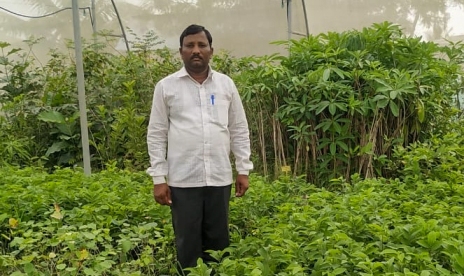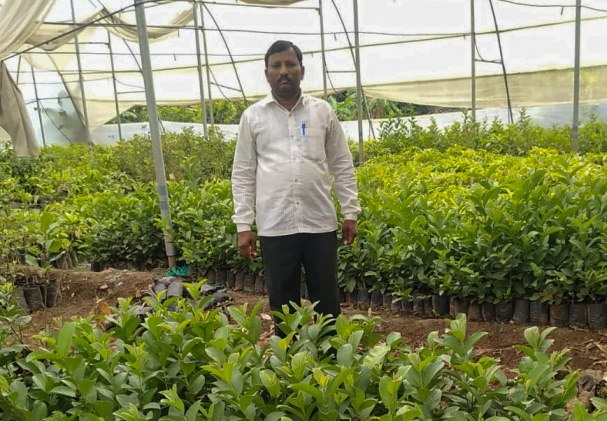Former Auto Mechanic Grows 22 Mango Varieties on One Tree! Earns Rs 50 Lakh/Year
Kakasaheb Sawant, an auto mechanic-turned-farmer from Sangli district of Maharashtra, shares how he grows the Kesar mango variety on 10 acres of land.

Having worked close to a decade for several Pune-based automobile majors, and now running a plant nursery that fetches him up to Rs 50 lakhs annually, Kakasaheb Sawant has come a long way.
“When I planted mangoes a decade ago, people laughed at me because they thought mangoes could only be grown in the Konkan, famous for its Hapus (Alphonso),” informs Sawant (43), dressed in a full-sleeved white shirt and dark trousers.

Sawant’s family, which includes his two primary school teacher brothers, own 20 acres of land in Antral village in Jat Taluka of Sangli district, Maharashtra. This is also a drought-prone region.
The village is home to over 280 families and is 15 km from the Jat town. Gifted with fertile black soil, the taluka comprises 125 villages and receives close to 570mm of rainfall. Their farming activities are at the mercy of nature’s vagaries, which locals term ‘hangami sheti’.
Farmers here either grow grapes or pomegranates and consider mangoes a ‘novelty’ and ‘exotic’. The preferred crops are bajra (pearl millet), maize, jowar (sorghum), wheat and pulses.
“Earlier, I worked as a faculty member for a technical institute at Sangli. When I was transferred, I decided to return to my village and take care of the family’s farmlands,” says Sawant, an automobile mechanic holding an Industrial Training Institute diploma.
He adds, “I have not regretted my decision as I earn much more today. I am also helping green the taluka through the fruit trees and wild plants that farmers and establishments like schools, panchayat offices, etc, source from my nursery.”
A Nursery Filled With ‘Exotic’ Fruit
Sawant established his mango orchard in 2010 and five years later, he saw a business opportunity in starting a nursery — Shri Banshankari Rop Vatika. To irrigate the trees he has laid two pipelines, both 4km long, to source water from the Mhaisal Irrigation Scheme of the Krishna river. Additionally, with a subsidy provided by the State’s Agriculture Department he has built a holding pond.
Currently, Sawant’s 15-member family resides in Banali, known for its deity Shri Banshankari and is 5 km from Antral. “In another two months we plan to move to our bungalow house in Antral which is under construction,” he says.
The family’s farm plots are equally divided into mango and non-mango orchards. The Kesar variety occupies 10 acres while the rest of the 10-acre plot has chikoos, pomegranates, custard apples, guava, tamarind, among other trees.
Sawant’s nursery has a shade-net and is spread across one acre while the mother plants, from where the saplings are grafted, stand on another 10 acres. These mother plants of the Kesar variety are the source for the scions to be grafted for the Raiwal mango variety’s rootstocks.
Each year he harvests 2 tonnes of mangoes per acre, totalling 20 tonnes, and has become a role model for other farmers in this water-scarce region. From just being an automobile mechanic Sawant has become an ‘agri-preneur’ and employs 25 people at his farm and nursery.
Sawant has availed of the different government schemes which offer subsidies for establishing a nursery, building a pack house, setting up a mango orchard and ultimately finding success. “Till he began the nursery, one had to source mango saplings all the way from Kolhapur or Konkan. Besides fatalities of the saplings, the cost, too, was huge which deterred most farmers from establishing an orchard,” informs Tukaram Kolekar, agricultural assistant, Maharashtra Government, Jat taluka. “Now the taluka boasts of a large number of mango plantations devoted to the Kesar variety, spread across 50 acres while more are coming up.”
Priced between Rs 40 to Rs 70 per sapling, Sawant sells around 2 lakh mango saplings a year and an additional 1 lakh of custard apple, jamun, fig, chikoo, guava, tamarind and lemon saplings, cumulatively.
To Graft Mango Saplings
Sawant hires malis, who come from Dapoli which is 225 km away from Sangli, to work at his National Horticulture Board licensed nursery. They prepare the grafted saplings from June to August and live with Sawant’s family and have their meals with them too. “They’re very skilled and I’ve picked up the sapling grafting techniques from them,” Sawant says.
Last year the malis were unable to reach Antral due to the lockdown, so Sawant sent a taxi to bring them to his nursery. These malis graft around 800 to 1000 saplings everyday, and earn Rs 3 per graft.
Saplings from his nursery have reached farmers in Parbhani, Beed, Osmanabad, Buldhana, Kolhapur, Bijapur, Athani, Belgaum, Indi and even parts of the Konkan region. “This year I was surprised to receive an order for 4 lakh saplings from Buldhana,” he informs.
Sharing some tips of grafting saplings, Sawant, who was awarded the title of ‘Udyan Pandit’ by the Maharashtra government, elaborates, “When choosing the branch to be grafted, make sure the leaves on it are not over four months old and the branch is tender with a tinge of green. The temperature outside should be between 25℃ to 30℃, which is during early May here.”
Farmers from far and near visit Sawant’s farm with dual intentions — to pick up saplings and to watch the horticulture wonder that is his farm. There’s a three-year-old mango tree with 22 varieties grafted on it, which at this time of the year, is laden with fruits in shades of green and labelled with names like individual museum exhibits. Some names you see are Sindhu, Dudhpedha, Kroton, Sonpari, Dasheri, Vanraj, Niranjan, Lalbagh, Taiwan, Amrapali, Alphonso, Baramashi and 10 others.
Always on the lookout for new mango varieties, Sawant hopes to reach the magic figure of a 100 grafts on the same tree in a couple of years.
(Edited by Yoshita Rao)
This story made me
- 97
- 121
- 89
- 167
Tell Us More
We bring stories straight from the heart of India, to inspire millions and create a wave of impact. Our positive movement is growing bigger everyday, and we would love for you to join it.
Please contribute whatever you can, every little penny helps our team in bringing you more stories that support dreams and spread hope.



















